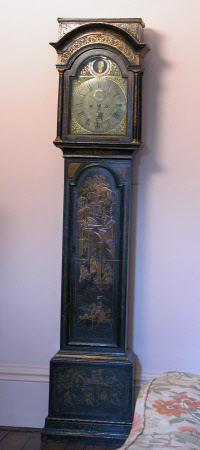Longcase clock
Samuel Townson (1672 - 1758)
Category
Horology
Date
c. 1710
Materials
Wood, Lacquer, Gilt, Brass, Steel
Measurements
2262 x 510 x 250 mm
Place of origin
London
Order this imageCollection
Greys Court, Oxfordshire
NT 195717
Summary
Long-case clock with black lacquered case decorated in gold, green and red, domed top, hood and door. Door panel shows man on horseback and dog in landscape and above two women entering a house with a woman in another doorway and one sitting on the verandah. At the top two figures sit before a building, set amongst trees. The base panel shows a figure being greeted by another seated on the verandah of a house set amongst trees. Gold geometric and flower designs elsewhere. Brass and steel eight day striking movement by Samuel Townson, London.
Full description
Long-case clock; case, made from wood and lacquer, made in England about 1710. Brass and steel eight day striking movement by Samuel Townson, London, about 1710. Most lacquered case clocks were made in the first quarter of the eighteenth century, though the lacquer period may be defined as c. 1700-1760. The clock in Grey's Court's Drawing Room therefore is a relatively early example. Such cases are generally made of softwood rather than the more common oak, probably because oak tends to change its shape more with humidity changes and crack lacquer or veneering. In terms of technique, the wood was coated with several layers of ground made from a white powder, On this, decoration was built up with coloured 'paste' so that is was in relief. The whole was then given a coat of transparent varnish. Colours most common in lacquered work are a black ground with other colours (blues, red, greens and golds) as is the case with the example in the Drawing Room, forming a pattern. The art of lacquer originated from Asia and most European designs imitated original versions made in China or Japan. It thas been claimed by some, such as Bruton, that clock case, or parts of them, such as the doors of trunks, went abroad to be treated. This is, however, disputed by scholars such as Brian Loomes. Samuel Townson was an early to mid eighteen century clockmaker based in London (also occasionally listed as Towneson) he was the son of Robert Townson and was apprentice to Thomas Wheeler on 1st may 1695. After his apprenticeship he became a Freeman of the Worshipful Company of Clockmakers (a London guild that is the oldest surviving horological institution in the world) from 1702 until at least 1738. A couple of sources, including Brian Loome's Clockmakers of the World vol. 2, also gave a date of 1760. Townson took an apprentice named Edmund Pottercary, son of Edmund, 3rd July 1738 for seven years and the fee of £12.
Provenance
Gifted to the National Trust by Sir Felix and Lady Elizabeth Brunner, along with Greys Court House and Estate, 1969.
Makers and roles
Samuel Townson (1672 - 1758), horologist
